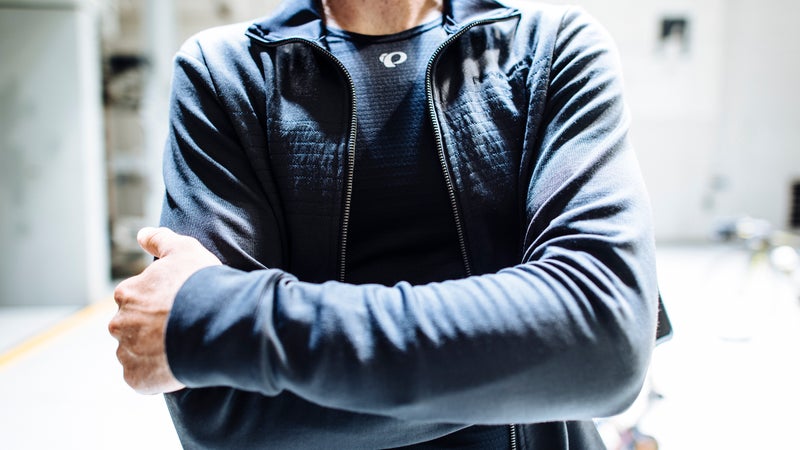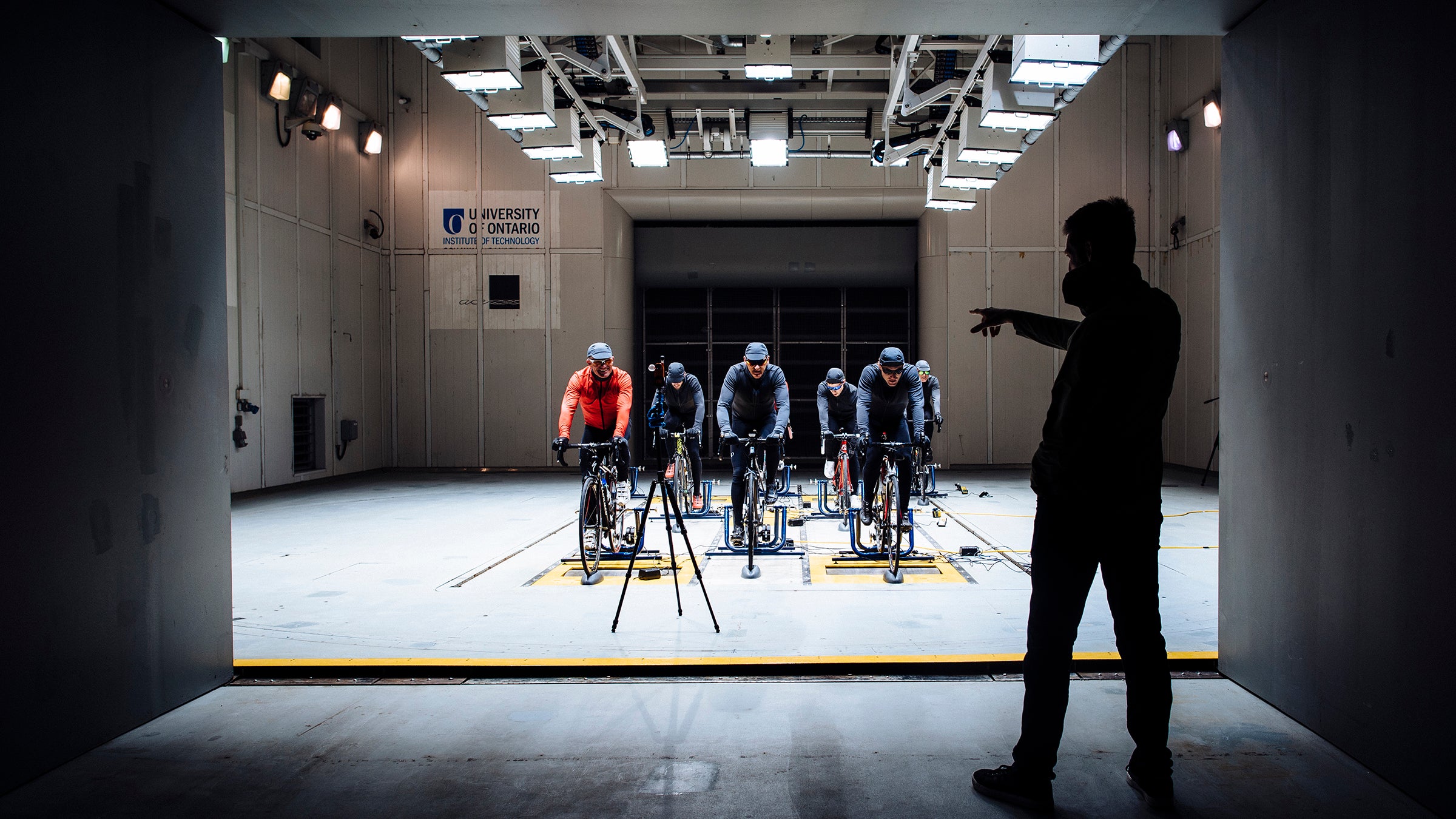For generations we’ve been told that staying dry is the key to comfort in the outdoors. If you don’t rapidly transport sweat out of your garments, the conventional wisdom held, you’re done for. So we’ve been dutifully wearing hydrophobic base layers and midweights made out of petroleum-based materials like polypropylene and polyester. Not only are such products tough on the planet, it also turns out that natural, more sustainable materials like Merino wool can do a better job at keeping you comfortable in the elements. We’re only now learning that moisture transport, while important, is only part of what helps fabrics keep us warm and dry. New research and next-gen weather simulation testing conducted by the cycling apparel company , in conjunction with , the global authority on Australian Merino wool, indicates that the PEARL iZUMi’s new keep you drier and warmer.
The Fabrics
While fabric makers have been combining wool and synthetic fibers in various ways for years, they're usually blended, with the fibers mixed equally throughout the fabric. PEARL iZUMi is doing things differently, combining the fibers in two distinct yarns on opposite sides of the textile—what fabric nerds refer to as “plaiting.” In the case of its , an upcycled polyester knit layer sits lightly against your skin and the wool is knitted towards the outside of the fabric. With the insulated , though, the Merino wool faces inward to absorb moisture vapor from the baselayer and maximize breathability while the nylon forms a more durable and weather-resistant outer fabric. Paired together, the two garments create an advanced performance layering system.
What ultimately makes the fabric work so well is that it combines the best properties of each fiber. The Merino wool component absorbs moisture vapor and keeps you insulated while damp, while its natural odor-resistant properties help reduce the funk factor. Meanwhile, the synthetic layer moves liquid moisture faster, dries quicker, and feels comfy next to your skin.
But it's not just about better performance. The plaited fabric is also easier on the planet: the synthetic component is made from 100% upcycled plastic water bottles while the responsibly sourced Merino wool is biodegradable and annually renewable. PEARL iZUMi's interest in using Merino wool began a few years ago with a major, company-wide initiative to incorporate recycled, renewable, and organic content into all of its products. By the end of 2020, 30% of its products will be made with these materials and the company is on track to hit its target of 90% sustainably-sourced fabrics by 2022.
The Test
The study was conducted outside Toronto this past July in a “climatic” wind tunnel, which in addition to wind also mimics real-world temperatures, humidity levels, and solar radiation. PEARL iZUMi’s lead researcher, the physiologist Rob Pickels, placed eight seasoned cyclists on trainers in a stiff 19-mile-per-hour wind in conditions that most of us would find on a fall day cold enough for full tights, gloves, and a . Swapping out their jerseys and baselayers after 40-minute trials including 30 minutes of pedaling and ten minutes of downtime in the same temperatures (to simulate a regroup on a ride), testers cycled through kits of identical weights and thickness. The kits included one fully synthetic offering and one with PEARL iZUMi’s new line of Merino wool-synthetic hybrid fabrics.
The researchers carefully measured the testers’ temperature at the skin surface and the humidity of the microclimate beneath the base layer—the objective data. On the subjective front, the testers were asked to rate how warm and dry they felt at the end of each spin and rest period.
The Results
On average, the test cyclists stayed five degrees Fahrenheit warmer with the two layers of Merino wool compared to the two layers of synthetics. Remarkably, the results showed that the rapid drying of the full synthetic kits correlated with colder riders—especially in the minutes after activity ended. Translation: while the full synthetic kits dried faster, the transfer of moisture was so fast it left them feeling chilled. The Merino wool hybrid kits, on the other hand, dried slower, but testers didn’t feel as chilled during the process. The take-away: all the qualities of the hybrid kits lead to increased rider comfort during both riding and rest.

The Science
It’s all about how the fabrics work together in tandem. “Polyester in the baselayer doesn't absorb a significant amount of liquid water,” says Pickels. “But because wool does absorb moisture vapor, it pulls sweat from your skin, through the polyester, and then stores it in the wool away from your body. When that happens, we believe, and other studies seem to indicate, heat is released and that heat travels back through the base layer to keep you warm. It’s the opposite effect of full-polyester systems, which move moisture so rapidly that the body cools in an evaporative process. We think it will allow cyclists to avoid chilling—especially when they come to a stop or turn around for a descent. In the jersey, we position the wool on the inside to work in conjunction with the baselayer for maximal heat release. The nylon face fabric helps pull moisture through to the jersey’s surface and then to the outside environment.”
The New Products
Merino LS Base ($90)
With an upcycled polyester layer against your skin and an outer Merino wool layer, the new (also available in ) actively pulls moisture vapor away from your skin and into the center of the outer wool fibers, keeping you both dry and warm. Testing found the base layer worked even better when paired with PEARL iZUMi’s Merino jersey—the combo resulted in the warmest body temperatures. Still more telling, while the testers were actively pedaling, the Merino base layer kept them drier too, by absorbing moisture vapor into the core of the fiber.
Pro Merino Thermal Jersey ($195)
Merino wool on the inside and a durable nylon outer with subtle but effective high-visibility treatments will make the your go-to piece when temps dip below 55 degrees in the long shadows of the shoulder seasons. The styling is also chill, meaning you won’t look like a road racer when you’re hammering gravel roads with friends. The full zip means it serves double duty as a jacket and a jersey.
Merino Cycling Cap ($40) and Neck Gaitor ($35)
The same plaited fabric that pulls moisture away from your skin without causing undue evaporative cooling in PEARL iZUMi’s Merino LS Base top is utilized here in a sleek visored cap and neck gaitor. To make the most of the tech, wear them on cool to cold rides in dry conditions.

